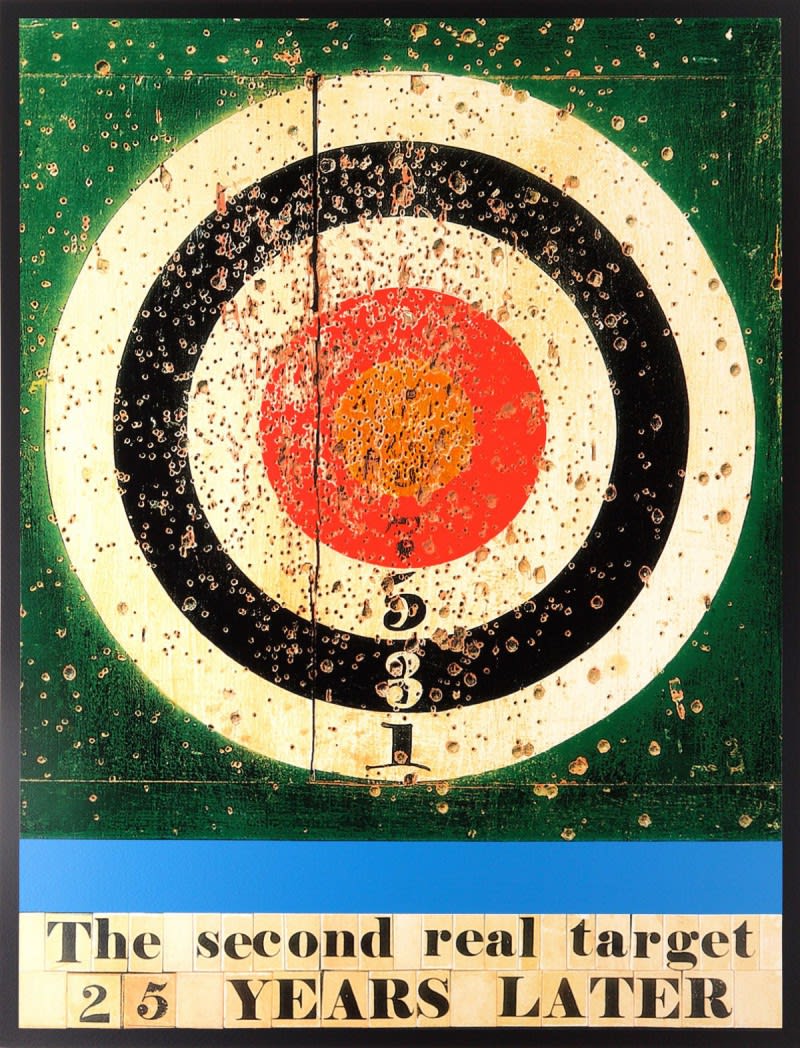Open a larger version of the following image in a popup:
 Click image to enlarge
Click image to enlarge
 Click image to enlarge
Click image to enlarge
Open a larger version of the following image in a popup:
 Click image to enlarge
Click image to enlarge
 Click image to enlarge
Click image to enlarge
Open a larger version of the following image in a popup:
 Click image to enlarge
Click image to enlarge
 Click image to enlarge
Click image to enlarge
Peter Blake
The Second Real Print Target, 2009
Silkscreen on Paper
Published by CCA Galleries
Printed at Coriander Studios
Published by CCA Galleries
Printed at Coriander Studios
880mm x 1117mm x 2mm
Edition of 100
Copyright The Artist
Further images
'The Second Real Target 25 Years Later' - A signed limited edition 29 colour silkscreen print with 8 spot colours, 2 woodgrain effects, embossing, satin and UV glazes, by pop...
'The Second Real Target 25 Years Later' - A signed limited edition 29 colour silkscreen print with 8 spot colours, 2 woodgrain effects, embossing, satin and UV glazes, by pop art legend Sir Peter Blake. Printed at Coriander Studios, published by CCA Galleries.
For Blake revisiting earlier works is an opportunity tie up loose ends, see connections finding sources of inspiration for new departures. "I felt that some of the American Pop artists had only one idea in the early 1960s, then repeated that idea over and over again, mainly for commercial reasons, whereas I had often only painted one picture from an idea, and it would sometimes have been worth further paintings." -
Peter Blake
From the mid-80s Blake started to re-examine his earlier work, exploring further ideas. Here he revisits an original piece from 1986, that itself was based on his The First Real Target? of 1961 (adapted for his silkscreen The First Real Print Target published by CCA in 2008). The concept of the target as subject matter was a result of the dialogue between Blake and Jasper Johns. Johns had made paintings of a target in 1960, prompting Blake to respond by equating the subject of the painting with its physical manifestation as an object. The First Real Target (enamel on canvas and collage on board support) was conceived in a spirit of both homage to, and competition with, Johns- taking the American's idea to a more radical level.
In these very simple pieces Blake is trying to achieve a hands-off look, denying his technical and painterly ability to make the painting as close to the real object depicted as possible, making the image more materially and tangibly present. This concept was extended to its logical conclusion when Blake re-visited the subject in 1986, when 'The Second Real Target 25 years Later' was made from a real wooden target with letters.
Part of Blake's drive to be an artist of the people rather than of the elite, was submerging his own artistic identity into that of existing styles from outside fine art traditions, presenting his paintings as if they were objects he had found ready-made in a timeworn condition.
For Blake revisiting earlier works is an opportunity tie up loose ends, see connections finding sources of inspiration for new departures. "I felt that some of the American Pop artists had only one idea in the early 1960s, then repeated that idea over and over again, mainly for commercial reasons, whereas I had often only painted one picture from an idea, and it would sometimes have been worth further paintings." -
Peter Blake
From the mid-80s Blake started to re-examine his earlier work, exploring further ideas. Here he revisits an original piece from 1986, that itself was based on his The First Real Target? of 1961 (adapted for his silkscreen The First Real Print Target published by CCA in 2008). The concept of the target as subject matter was a result of the dialogue between Blake and Jasper Johns. Johns had made paintings of a target in 1960, prompting Blake to respond by equating the subject of the painting with its physical manifestation as an object. The First Real Target (enamel on canvas and collage on board support) was conceived in a spirit of both homage to, and competition with, Johns- taking the American's idea to a more radical level.
In these very simple pieces Blake is trying to achieve a hands-off look, denying his technical and painterly ability to make the painting as close to the real object depicted as possible, making the image more materially and tangibly present. This concept was extended to its logical conclusion when Blake re-visited the subject in 1986, when 'The Second Real Target 25 years Later' was made from a real wooden target with letters.
Part of Blake's drive to be an artist of the people rather than of the elite, was submerging his own artistic identity into that of existing styles from outside fine art traditions, presenting his paintings as if they were objects he had found ready-made in a timeworn condition.


